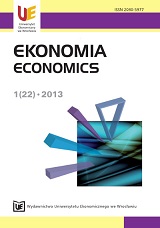Efektywność dydaktyki w uczelniach publicznych w Polsce
The efficiency of teaching in Polish public universities
Author(s): Michał ŚwitłykSubject(s): Economy
Published by: Wydawnictwo Uniwersytetu Ekonomicznego we Wrocławiu
Keywords: efficiency; DEA method; public universities
Summary/Abstract: The aim of the study is to determine the technical efficiency of teaching in public universities, a ranking of their effectiveness and efficiency during study. We analyzed the supervision of public institutions subordinated to the Ministry of Science and Higher Education. For the calculation with the DEA method input-oriented models were used. The study used the DEA CCR model and BCC and super efficiency model. Malmquist Index was applied in order to determine the effectiveness of changes in time. For the calculation using the DEA method a model of university was adopted which consisted of one output and five input variables. This model took the form: effect (output): the value of the funds raised to finance teaching (thousand of zł). Input variables (inputs) were materials and energy (thousand of PLN), the value of third-party services (thousand PLN), the value of the gross wage (thousand PLN), depreciation (thousand PLN), the other generic cost by type (thousand PLN). The study was conducted in 2001-2010. Technical efficiency ratios CCR model ranged from 76.6% (2008) to 89.5% (2002); in a model of BCC they were from 90.0% (2008) to 93.3% (2005), and scale efficiency ratios ranged from 85.5% (2008) to 96.5% (2002). The lowest technical efficiency of teaching during the period characterized technical and agriculture universities. The University of Warsaw took the first place in the ranking followed by the Academy of Physical Education in Cracow, University of Humanities and Sciences in Kielce and the Academy of Special Education in Warsaw. Agriculture (University of Agriculture in Szczecin and University of Technology and Life Sciences in Bydgoszcz) and technical (Koszalin University of Technology and the Technical University of Radom) universities took the last place in the ranking. In the years 2002−2008 the average Malmquist index changes were 1.5% and efficiency changes were negative and amounted to -0.2%, and changes in technical progress amounted to 1.7% per year. Malmquist index size is due to changes in the rate of technological progress. In the analyzed period, the highest values of Malmquist index were reported at: Technical University of Wrocław (1.107), Koszalin University of Technology (1.092), the Academy of Physical Education in Cracow (1,080), University of Łódź (1.067) and Silesian University of Technology (1.063)., The lowest values of Malmquist index were characterized by University of Technology in Kielce (0.975), the Academy of Physical Education and Sport in Gdańsk (0.973), Technical University of Opole (0.966), the Academy of Special Education in Warsaw (0.961), University of Technology and Humanities in Bielsko-Biała (0.955).
Journal: Ekonomia
- Issue Year: 2013
- Issue No: 22
- Page Range: 9-28
- Page Count: 20
- Language: Polish

